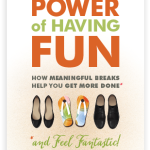Do your employees come to work just to collect paychecks? Want them to become brand evangelists? Then, place “fun” on the top of your HR strategy. Seriously.
The competitive marketplace for top talent is ruthless. Being a bland, vanilla, or, worst of all, insensitive place to work is bad for your brand. According to the Harvard Business Review and the Energy Project, empowering employees to have fun makes them feel healthier and happier. Why not create a program that encourages meaningful, fun breaks throughout the day, week, month, and year?
Consider LinkedIn and how it offers monthly events called “InDays.” Each InDay, LinkedIn encourages its employees to innovate, think creatively, or work on inspirational projects.
Does this lead to success? LinkedIn boasts a top-10 ranking on Glassdoor as one of the best “large” places to work, and CEO Jeff Weiner holds a top-5 CEO ranking.
 The following excerpt from my new book The Power of Having Fun details how employees have lost their way. It dives into the research that shows how taking unstructured breaks throughout the day helps us refocus and be more productive. We live in a world where non-stop work and no-play are the standard. It’s time to take control of our own destiny… and productivity!
The following excerpt from my new book The Power of Having Fun details how employees have lost their way. It dives into the research that shows how taking unstructured breaks throughout the day helps us refocus and be more productive. We live in a world where non-stop work and no-play are the standard. It’s time to take control of our own destiny… and productivity!
∼∼∼∼
Are you unhappy with your job? Do you feel like your manager doesn’t respect you? Do you feel like the CEO has no clue about what’s going on at your level in the company? If so, you’re not alone.
So many workers imagine the “perfect” work environment and strictly affix their notion of happiness to that ideal. They make the pinnacle of happiness and well-being contingent upon how well their current job lines up with the model that they’ve created in their mind.
A recent Gallup survey found that only about one-third of US employees consider themselves engaged at work. This means that about two-thirds could care less — or are even hostile — about the work they’re doing and the company they’re working for. It’s even worse outside the United States, with over 80% of employees in the disengaged category.
Yet companies with highly engaged workforces outperform competitors by 147%. Each year, Fortune magazine enlists the aid of the Great Place to Work Institute to compile The Fortune 100 Best Companies to Work For® list. Companies covet and seek membership to this rare group. Talk about a recruiting boost!
For all employees who work for the companies on the list, the phrase “this is a fun place to work” most highly correlated among all survey statements with this phrase: “Taking everything into account, I consider this a great place to work.” Translation: If you want a workplace that attracts and retains top talent, make it a fun place to work.
And if you want to love your work, find a way to infuse moments of fun into your day.
It’s not about satisfaction
In a long list of the wonderful aspects of your job, odds are there’s at least one annoying sliver in your pinkie finger that’s making you rethink your career choices. As an employee, you ride a roller coaster of emotions fueled by the Culture of WISH (Worth It Someday Hopefully).
It says, “Someday, hopefully, the perfect workday will land on your lap and nuzzle you like a kitten. In the meantime, buck up! Just put your head down and plow ahead. That’s how your forefathers’ forefathers built this land, after all.”
By sacrificing immediate fun in the hopes of getting some joy down the line, you’re falling victim to fallacy. Here’s a little secret that you may not be aware of: everybody does stuff that they don’t want to do at work.
I’m sure there are plenty of readers of this book who would say they love their job but can find something about it they despise. My nemesis? Editing. Yuck. While we can occasionally delegate portions of job ugliness, for neither you nor me is there such a thing as the 100 percent perfect job. If we sit around waiting for the perfect job to throw us the keys and “have a good time,” we’re always going to feel as if we’re being cheated.
Culture of WIN
However, the Culture of WIN (Worth It Now) creates a different reality. It gives us the right to predetermined breaks that we can use to step away regardless of the experiences that we may be having at the moment. Whether we’re happy or unhappy with our job is irrelevant. The point is that we can take these breaks to make sure that it is always worth it now.
That it will be worth it each day, week, month, and year. In this way, we can be happy at work regardless of externalities. As the Dalai Lama once said: “If you have fear of some pain or suffering, you should examine whether there is anything you can do about it. If you can, there is no need to worry about it; if you cannot do anything, then there is also no need to worry.”
Translation: You can do something about your happiness at work, so there is no need to worry. Who bears responsibility for making these changes? In my experience, and with a non-scientific estimate, here is how I see the “fun responsibility” divvied up in the workplace.
 Enjoy this tasty pie chart: That big fat slice says that you are mostly in control of your workplace happiness. No need to sit around waiting for someone to swoop down from the heavens and save the day.
Enjoy this tasty pie chart: That big fat slice says that you are mostly in control of your workplace happiness. No need to sit around waiting for someone to swoop down from the heavens and save the day.
